Umbrella plants are easy to grow, and they don’t require very much hands-on care. In this post, I’ll show you all you need to know to be successful and keep your plant thriving for many years to come.
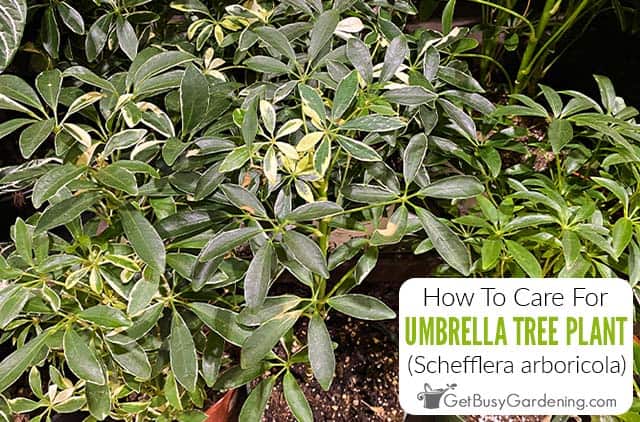
The fact that umbrella plants are low maintenance makes them a great indoor option for beginner gardeners.
But learning how to care for them correctly is important, even for this easy houseplant.
This complete guide is designed to help you learn about umbrella plant care, so that you can feel confident adding one to your collection.
Below you’ll find all the key information on water, soil, light, temperature, pruning, propagation, pest control, and much more.
Quick Umbrella Tree Plant Care Overview
| Scientific name: | Schefflera arboricola |
| Classification: | Tropical plant |
| Common names: | Umbrella Plant, Dwarf Umbrella Tree, Hawaiian Umbrella Tree, Arboricola Tree |
| Hardiness: | Zones 10-12 |
| Temperature: | 55-75°F (13-24°C) |
| Flowers: | White, spring-summer |
| Light: | Partial shade outdoors, bright indirect light indoors |
| Water: | Allow soil to dry between waterings, do not overwater |
| Humidity: | Average to high |
| Fertilizer: | General purpose fertilizer spring-summer |
| Soil: | Well-draining, fertile, loose |
| Common pests: | Scale, spider mites, aphids |
Information About Dwarf Umbrella Trees
Umbrella plants, or dwarf umbrella trees (Schefflera arboricola), are tropical evergreens native to Taiwan. They’re smaller than other Schefflera species, and commonly grown as houseplants.
They’re also air-purifying plants, and can reach heights of 30’ outdoors. Indoors they typically reach a maximum of 6’ tall and 4’ wide.
They have thin stems with branching stalks that produce elongated oval leaves. The common name comes from the umbrella shape that the foliage forms at the top of each branch.
Different Varieties Of Schefflera arboricola
There are two main types of dwarf umbrella trees, common green and variegated, and they both require similar care.
The common variety has glossy, green leaves. This one can tolerate lower temperatures and less sunlight.
Schefflera arboricola ‘variegata’ features beautiful yellow mottling on the leaves. It prefers brighter light and warmer temps.
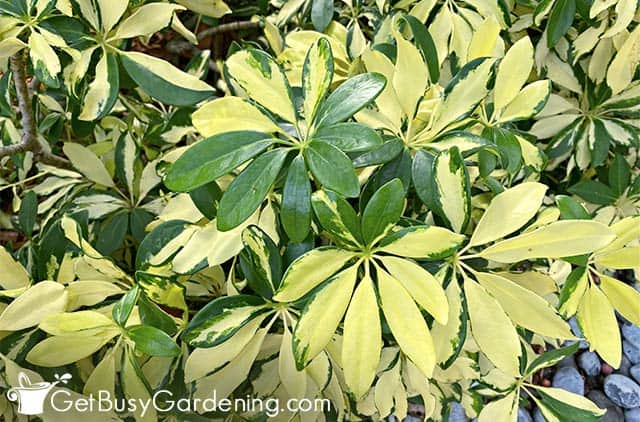
Flowers
Umbrella plants can bloom with the proper care and in very bright, warm, and humid environments, but it’s very uncommon indoors.
They produce flower plumes between spring and summer that feature clusters of small, white blossoms and red stalks.
In the perfect environment, they can even produce tiny inedible orange-red fruits after flowering.
Toxicity
According to the ASPCA website, Schefflera arboricola is toxic when ingested. If this is a concern for you, it’s best to keep it out of reach of children, cats, dogs, and other pets.
How To Grow An Umbrella Tree Plant
Before we dive into the details of dwarf umbrella tree plant care, first we should chat about where to grow them. Choosing a good location is the first step in having a thriving, healthy plant.
Hardiness
Umbrella plants are not cold hardy and will begin to suffer at temperatures under 55°F (13°C).
They can be grown outdoors year around in zones 10-12. But in colder regions you’ll need to grow them as houseplants, or moved indoors when temperatures drop in the fall.
Where To Grow A Dwarf Umbrella Tree
The best location to grow your Schefflera arboricola indoors is in an area that gets lots of bright, indirect light.
Outdoors they’ll need a partial shade location to protect them from the intense afternoon sun, which can burn their tender leaves.
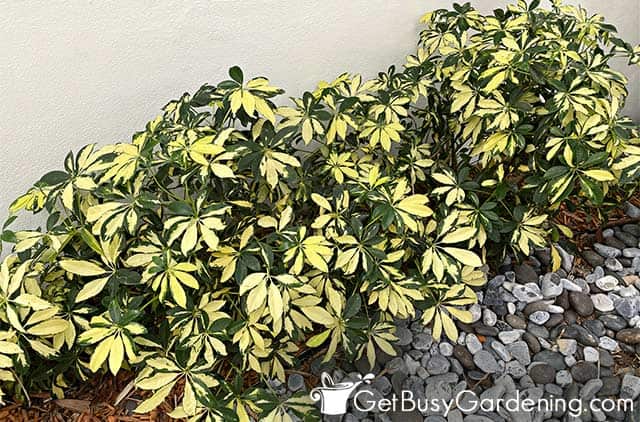
Umbrella Plant Care & Growing Instructions
Now that you know how to choose the ideal location, let’s chat about how to provide the best umbrella plant care. Use the tips below to keep yours happy and thriving.
Light
Schefflera arboricola needs at least 4 hours of bright light each day, however the foliage can burn in the direct afternoon sun.
So choose a spot that only has morning or evening exposure, or offers diffused or indirect light.
Indoors, rotate them every few weeks to make sure they grow straight and don’t bend toward the light.
They can tolerate lower light settings, but will grow slower and could become leggy. Add a grow light to supplement if your home is too dark.
Water
Umbrella plants are drought-tolerant and don’t like to be too wet. It’s better to err on the side of underwatering, as overdoing it can quickly lead to root rot.
Check that the soil has dried 2” down before giving them a drink. You can use a moisture gauge to help monitor it if you struggle to tell on your own.
Water deeply and then let all the excess drain completely from the container. Be sure to empty the drip tray, and never leave the pot sitting in water.

Humidity
Dwarf umbrella trees can tolerate average humidity, but will really thrive in environments with slightly higher levels.
Higher humidity also a great tool against spider mites, which are a common pest for them. Add a small humidifier or set them on a pebble tray to help increase it.
Temperature
The ideal temperature range for a Schefflera arboricola is between 60-75°F (16-24°C).
Though they can tolerate it getting down to 55°F (13°C), they will begin to suffer leaf drop in colder weather, and can eventually die.
In warmer temperatures, they may need more frequent watering and extra protection from the direct sun.
Fertilizer
Fertilizer is not a requirement for umbrella plant care, but regular feeding in the spring and summer can stimulate faster growth.
Use a diluted, balanced, liquid houseplant fertilizer monthly, or apply slow-release granules once per season.
Stop feeding in the fall and winter, or if your plant has reached a height that you don’t want it to exceed.
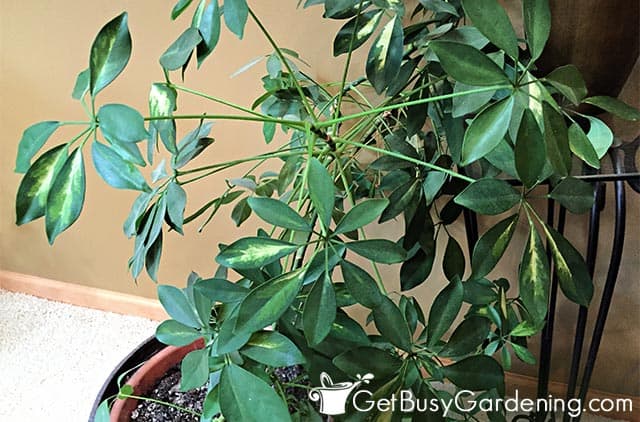
Soil
The ideal soil for umbrella plants is a loose, well-draining medium that’s rich in organic matter.
A quality general purpose potting soil is often suitable, but you can amend it with perlite or pumice to improve drainage, if needed.
Repotting
Dwarf umbrella tree plants can be very fast growing, and you may need to repot them every 1-3 years.
Wait until you begin to see roots peeking out of the bottom holes, or for signs of slowed growth.
Wait to do it until the early spring, then place them in a new pot with drainage holes, and one that is 1-2 sizes larger than the original.
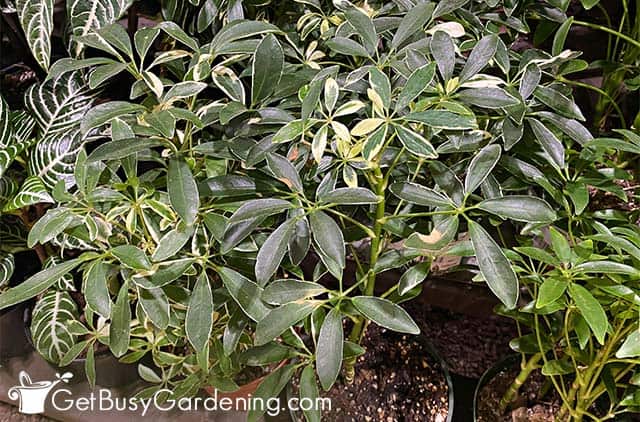
Pruning
Pruning isn’t a requirement for their care, but it’s a great way to prevent or fix legginess, and also to control the height of your umbrella plant.
They can handle a hard pruning, so use precision shears to snip away any sparse or dying stems in the spring to encourage bushier growth.
You can also pinch back the top to prevent them from getting any taller, once you’re happy with the height.
Pest Control Tips
Umbrella plants are unfortunately susceptible to aphids, spider mites, and scale. If you notice any insects, treat them immediately.
Spray or wipe neem oil or insecticidal soap on the leaves to get rid of the bugs. I make my own by combining 1 teaspoon of gentle liquid soap with 1 liter of warm water.
Umbrella Plant Propagation Tips
The best way to propagate umbrella plants is by taking stem cuttings. In the spring use clean, sterile pruners to snip a 4-6” stem below a leaf joint.
Remove all but the top most set of leaves, then dip the cut end in rooting hormone. Place it in damp soil somewhere warm, bright, and humid.
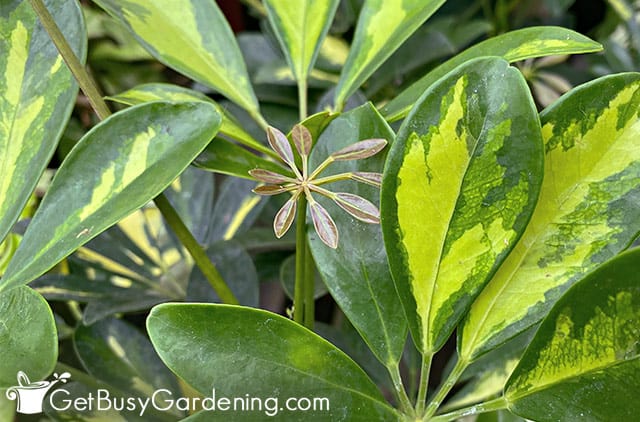
Troubleshooting Common Problems
Schefflera arboricola are easy-care and low-maintenance plants, but you still might run into one of these issues over time. Use the tips below to get yours back in good health.
Leaves Dropping / Falling Off
Dropping leaves is usually an indication that your umbrella plant is receiving too much sun, too much water, or has been exposed to cold temperatures.
Keep them above 55°F (13°C), out of direct sun, and wait for the soil to dry 2″ deep before watering.
Yellow Leaves
Yellowing umbrella plant leaves could indicate too much or low sunlight exposure, or improper watering.
Use a moisture gauge to help you determine when they need a drink. Provide at least 4 hours of bright light a day, but make sure to keep them away from direct sun.
Plant Drooping
A drooping Schefflera arboricola usually means they’re suffering from improper watering. Too little will cause them to wilt, while too much can easily cause root rot.
Let the medium dry out several inches down between drinks, and always make sure excess water drains away completely so they’re never left sitting in it.
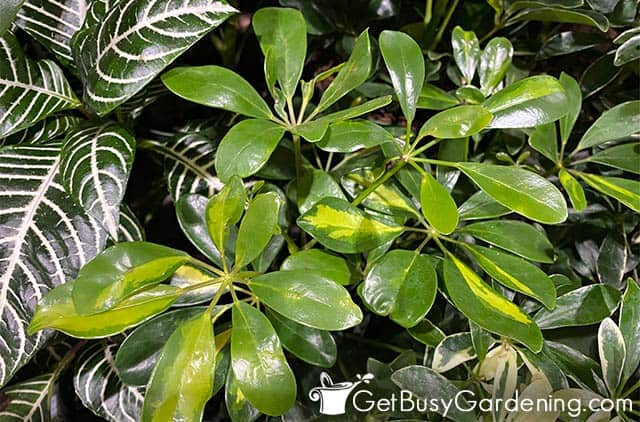
FAQs
Here I’ve answered some of the most commonly asked questions about umbrella plant care. If yours isn’t on the list, please add it to the comments section below.
Are umbrella plants easy to care for?
Yes, umbrella plants are very easy to care for, as long as you provide them with medium to bright indirect light, and water when the soil dries out.
Is Schefflera arboricola toxic to pets?
Yes, Schefflera arboricola is toxic to pets when ingested, according to the ASPCA website. It’s best to keep it out of reach of your cats and dogs.
How long do umbrella plants live?
An umbrella plant can live for 25 years or more with the proper care and ideal environment.
Is an umbrella plant good for indoors?
Yes, an umbrella plant is good for indoor areas because they thrive in moderate temperatures, indirect light, and don’t require high humidity or frequent watering.
Now that you know how easy umbrella plant care is, you can feel confident adding one to your houseplant collection. Use the tips here to create an environment that they’ll love and thrive in.
If you want to learn all there is to know about maintaining healthy indoor plants, then you need my Houseplant Care eBook. It will show you everything you need to know about how to keep every plant in your home thriving. Download your copy now!
More Houseplant Care Guides
- How To Care For Foxtail Fern (Asparagus densiflorus ‘Myers’)
- How To Care For A Lipstick Plant (Aeschynanthus radicans)
- How To Care For Cat Palm (Chamaedorea cataractarum)
- How To Care For Goldfish Plant (Nematanthus gregarius)
Share your dwarf umbrella tree plant care tips in the comments section below.

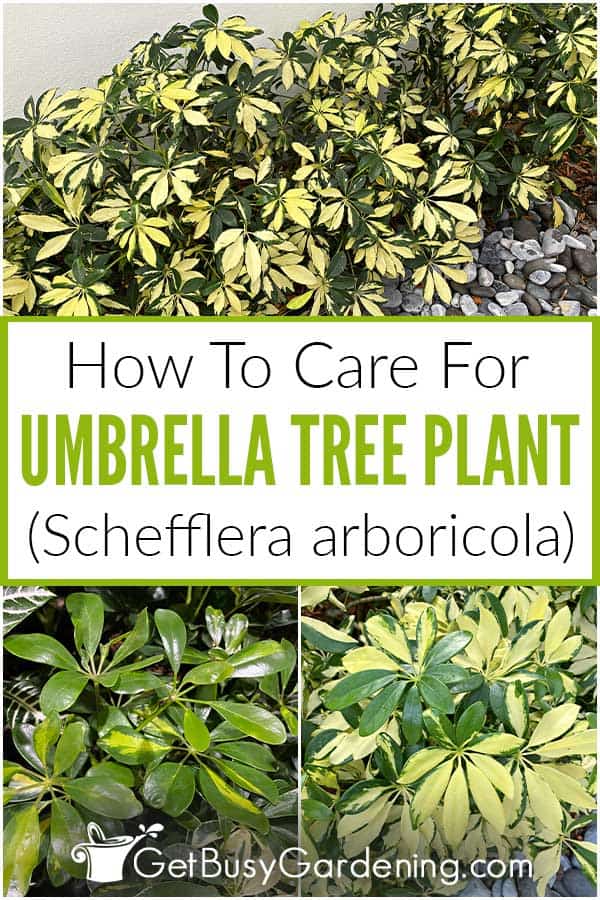
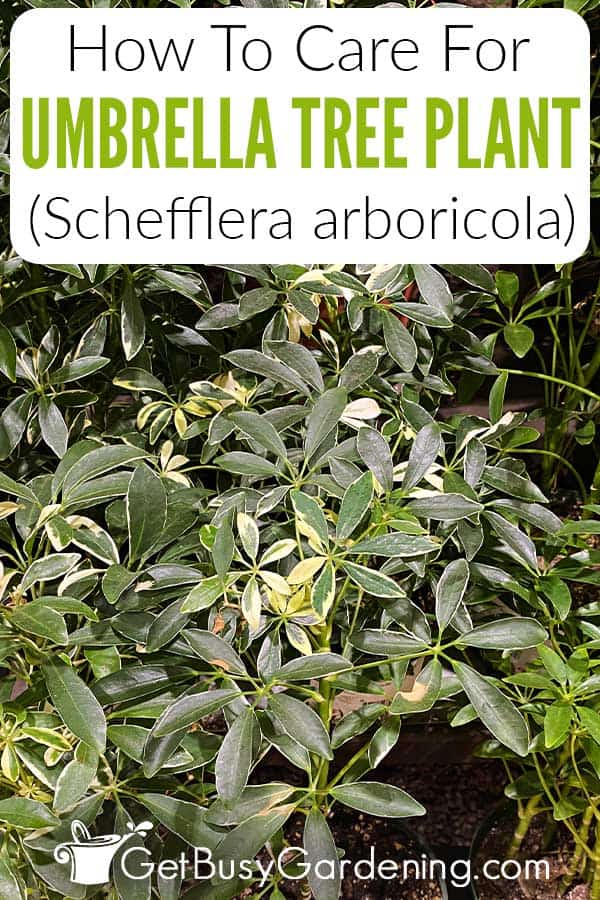



Leave a Reply